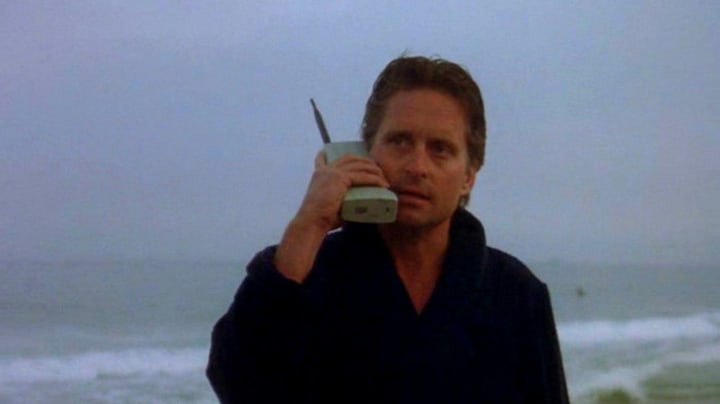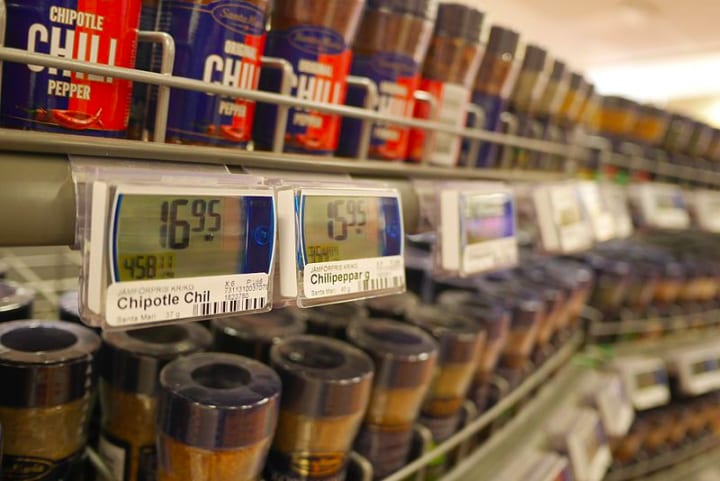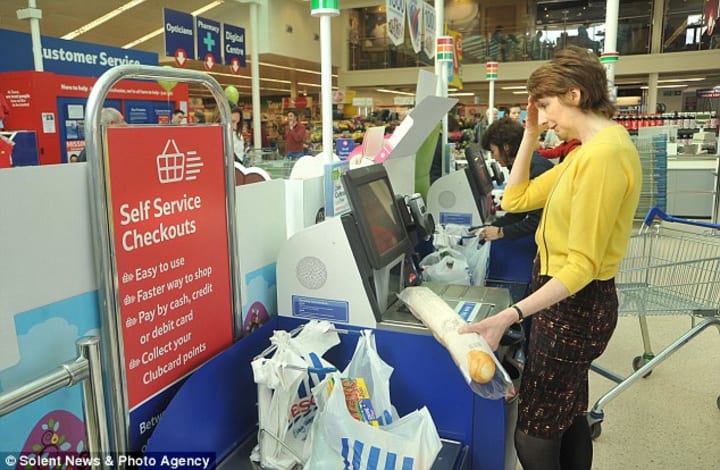Will the Future of Retail Be Augmented?
Analysts are pointing to augmented reality as being the next big thing for retail, perhaps a way to distinguish—and even save—"traditional" stores. Here's why shopping in the not-so-distant future may be a little like 'Minority Report.'

How many times have we seen it happen in just the span of our own lives? How many times have we seen the stuff of science fiction come to life? How many times have we seen characters in a movie from two decades ago, a decade ago, or heck, even two to three years before do something that was futuristic then but is commonplace today? How many times have we been watching a TV show from a decade or two ago and get frustrated at the plot and yell out, "Why doesn't he just send her a text already!"
From Dick Tracy's wristwatch to talking cars to smartphones to video conferencing, all of us—especially those of us who carry an AARP-card—can point to things in books, movies, and television that seemed ahead of one's time—perhaps even implausible—"back in the day." And yet, in today's tech-enabled world, the devices and the tools we have all cumulatively form the way things are and indeed, the technologies together have turned out to be integral into how we live and how we work today.
We realize how almost every episode of Seinfeld could have been easily resolved if they had a cellphone or could check Google.
We can now laugh heartily at things like Michael Douglas walking on the beach in the movie, Wall Street, talking into a cellphone that is bigger than a good-sized cantaloupe—and weighs more than one, too!


And so now we see the future coming fast to the retail environment. Who would have ever dreamed about some of the things that were once mind boggling, futuristic innovations that we now take for granted in the retail experience? How long ago was the notion of electronic shelf pricing that could be changed on a moment's notice considered far-fetched?

How long ago would we have thought having a robot roaming the aisles at Lowe's to provide customer assistance was something from 2118, rather than 2018?
And while we might think that going to WalMart and never having to get out of our car or set foot in the store to get our grocery order—and maybe even while still wearing our pajamas—is a pretty cool notion...
I can safely say that we never imagined the nightmare that we see today, with customers being their own cashiers with self-service checkouts. Need we say the "roll-through" airport security style checkout—where your items are totaled and your credit card is charged—just can't get here soon enough!

And yet when we think about the future of retail, many of us turn to the shopping experience of Tom Cruise in the now 15-plus-year-old film, Minority Report. In a scene from the movie, based on the science fiction short story by Philip K. Dick, Tom Cruise's John Anderton character famously moves through a mall and then into a Gap store (I guess that means the Gap will survive the current "Retail Apocalypse!") where ads and displays interact with him based on his location and his eye movements. In short, it depicts an augmented reality for retail that really—by many experts' estimates—is not that far away today. And in the minds of a growing number of retail analysts, augmented reality—in a weird strategic twist—may just be the application that helps save the traditional "store" as we know it today.

And so as a management consultant and professor, I read with great interest a recently released article from eMarketer, a marketing and analytics analysis and research firm. Authored by Caroline Cakebread (yes, that's her real name!), a junior analyst with the company, the piece was entitled, "It’s Too Risky for Brands to Stay on the Sidelines of Augmented Reality." In the article, Ms. Cakebread interviews Keith Soljacich, who currently is a vice president in charge of experiential technology with Digitas, a London-based global marketing and technology consultancy. If you want to see what the future of retail may really look like in just a relatively short time—and consider how your company fits into a future when augmented reality shopping experiences will be common—even expected—when we go about shopping in a physical store—this article is essential reading.
The insightful piece examines what augmented reality will bring to the retail environment. Now, to serve as your professor, I have to interject a point here to differentiate AR (augmented reality) from VR (virtual reality) and make sure everyone understands why it is so important to distinguish between the two technologies. The video below provides a great primer and overview on these two very different forms of assistive technology, all in a manner that both techies and non-techies can appreciate.
And if you want to see just how far an AR-enabled future shopping experience might go, I strongly encourage you to watch the video below:
And so now, returning to the eMarketer Q & A between Ms. Cakebread and Keith Soljacich, the prediction is that while virtual reality gets most of the headlines and media attention today, it is augmented reality that will have the most impact—and be most accessible and meaningful to consumers and retailers alike—in the retail store environment. When asked just how AR would work for products in the store environment, Soljacich provided the following quite illustrative example about a quite mundane kitchen appliance:
When AR takes off, your digital presence will be everywhere and it will become your product. For example, take a KitchenAid stand mixer. Sitting on a shelf, you can learn quite a bit about it, but when you apply an AR layer to that stand mixer, the product comes to life. You can see it work and interact with it, or change the colors and try different attachments.
Now, think about what an exciting proposition what Soljacich labels as the "AR Cloud" will soon provide for both consumer products companies and retailers. As he explains:
Essentially, it's duplicating our real environment by scanning the world and turning it into an interactive layer. For example, right now, it would be like if you were going to pull something up and learn about it by Googling it. In addition to the data, there would be the actual physical manifestation of the world—a real presence.
This AR Cloud will thus provide shoppers the chance to view the "product" in the store in new and exciting ways. Thus, for both retailers and the consumer products companies who supply them, the challenge will be what we—as shoppers—will come to expect to see in the store and how we will both draw upon and use this information.
Certainly, AR applications can take on a variety of forms. Want to see the product in a different color? The AR Cloud could show it. Want to see reviews on the product? The AR Cloud could call them up for you. Want to see price/performance/spec comparisons between alternative products? The AR Cloud could provide them for you. Want to order the product for pickup in the store that day or have one shipped to your home address? The AR Cloud could make the purchase happen seamlessly. This could take the whole notion of "showrooming" to a whole new level—and give physical stores a real advantage in competing for shoppers as the in-store experience. Providing consumers with the ability—and perhaps new ways and new incentives—to complete the transaction in the store and not online could make retailers rethink the entire retail experience.
And Soljacich sees this all happening very quickly—perhaps far sooner than many in retail could ever imagine. He predicted that:
In five years, I absolutely think we will have a virtualized version of our real world. The big game changer will be the combination of AR and computer image recognition with geolocation awareness. Whether we still use our smartphones or head-mounted AR displays, the concept of entering text to get information is going to change to pointing your camera at something you want to learn about and retrieving the information that way. There will be a shift from text entry to more visual entry.
While VR experiences and applications will prove to be game-changing in the coming years, meaning everything from how we watch sports to how we learn and how we teach to yes, how we engage with porn (and yes, the pornography industry seems to lead in the practical application of almost every Web-enabled technology that has ever come down the pipe!), the critical differentiating point between AR and VR is that our interactions with augmented reality will be far more frequent—and easy. As Soljacich explained:
In terms of use and scale, AR is going to bypass VR exponentially—we won’t think of AR as a channel but more so just core to everything we do. Whether it’s mapping or finding information, there’s much more volume to the AR experience. We’ll have 10 or 20 AR experiences a day, and VR is still going to be like your TV or Playstation console where you’re choosing to sit down and play the game.
The simple fact that as we go about our daily lives, the very notion that AR will be something we interact with unintentionally versus having to intentionally don a clunky, immersive VR headset that is connected to a VR device is the differentiating factor between the two technologies. Augmented reality, whether we access it primarily still using our smartphones or we view the world in an augmented manner through something akin to Google Glass, has the very real potential to become common, perhaps even ubiquitous, as we work, as we drive, and yes, as we shop. For all of us then, we will likely see augmented reality bring about real changes in how we do things—hopefully, for the better!
And for retailers in particular, AR should be looked upon as an exciting, truly game-changing prospect. Whether we will still "point" our phones at an object on a shelf or the shelf will recognize our eye movements toward the item to express interest (in a very "Minority Report"-kinda way that may seem creepy to many of us today, but be simply "the way things are done" in a decade or so), the very notion that a product and how we display it can become truly interactive with the customer should be an exhilarating proposition.
All of this does lead to key questions however:
- How will all of this evolve and exactly how quickly will it do so?
- How will smaller retailers compete on AR versus the bigger chains with the necessary investments to be made to support the technology?
- How much of the technology will come from consumer products companies versus the retailers themselves?
- How can retailers control what, how, when, and to whom the AR is displayed?
- How can retailers and consumer products firms make AR technology more accessible—and more useful—to all shoppers (not just the younger generation and even the differently-abled—and the differently tech-enabled!)?
- Will government get involved to regulate how AR is used and what information is provided to shoppers?
- And of course, how will the lawyers get involved in all of this—and how will the law keep up with the rapid development of technology in this area?
- Finally, and most importantly, how—and how much—will consumers come to use augmented reality in their shopping behavior?
All of these are important questions that will play out over time, and indeed, they will have to be worked out for AR to see full-scale development. However, in the world of retail, there may not have been a development rivaling the coming widespread implementation of augmented reality since the Web and the explosion of online commerce. And for all retailers, it will be important to not just monitor developments in this area, but to be proactive at exploring how AR might fit into your strategy and operations not in some science fictionalized version of the future, but today!
Engage with the Author
Learn more about noted management consultant and Professor David Wyld and his work by visiting the following link:
About the Creator
David Wyld
Professor, Consultant, Doer. Founder/Publisher of The IDEA Publishing (http://www.theideapublishing.com/) & Modern Business Press (http://www.modernbusinesspress.com)






Comments
There are no comments for this story
Be the first to respond and start the conversation.